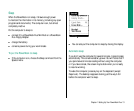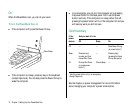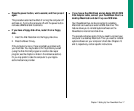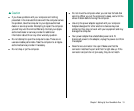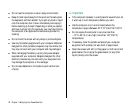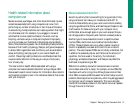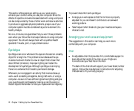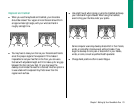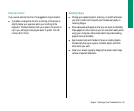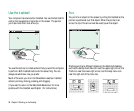
Health-related information about
computer use
Muscle soreness, eye fatigue, and other discomforts and injuries
sometimes associated with using computers can occur from
performing any number of activities. In fact, misuse of the same
muscles during multiple activities can create a problem that might
not otherwise exist. For example, if you engage in nonwork
activities that involve repetitive stress on the wrist—such as
bicycling—and also use your computer’s keyboard improperly,
you may increase your likelihood of developing wrist problems.
Some individuals are at greater risk of developing these problems
because of their health, physiology, lifestyle, and general exposure
to stress. Work organization and conditions, such as workstation
setup and lighting, also play a part in your overall health and
comfort. Preventing health problems is a multifaceted task that
requires careful attention to the way you use your body every
hour of every day.
The most common health effects associated with using a
computer are musculoskeletal discomfort and eye fatigue. We’ll
discuss each area of concern below. For information about electric
and magnetic emissions, look in the reference material that comes
with your computer.
Musculoskeletal discomfort
As with any activity that involves sitting for long periods of time,
using a computer can make your muscles sore and stiff. To
minimize these effects, set up your work environment carefully,
using the guidelines that follow, and take frequent breaks to rest
tired muscles. To make working with your computer more
comfortable, allow enough space in your work area so that you
can change position frequently and maintain a relaxed posture.
Another type of musculoskeletal concern is repetitive stress
injuries (RSIs), also known as cumulative trauma disorders
(CTDs). These problems can occur when a certain muscle or
tendon is repeatedly overused and forced into an unnatural
position. The exact causes of RSIs are not totally understood, but
in addition to awkward posture, such factors as the amount of
repetition, the force used in the activity, the individual’s
physiology, workplace stress level, and lifestyle may affect the
likelihood of experiencing an RSI.
RSIs did not suddenly arise when computers were invented;
tennis elbow and writer’s cramp, for example, are two RSIs that
have been with us for a long time. Although less common than
other RSIs, one serious RSI discussed more often today is a wrist
problem called carpal tunnel syndrome, which may be aggravated
by improper use of computer keyboards. This nerve disorder
results from excessive pressure on the median nerve as it passes
through the wrist to the hand.
Chapter 1: Setting Up Your Powerbook Duo 21



